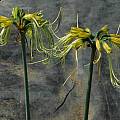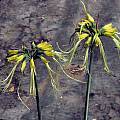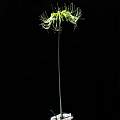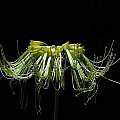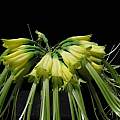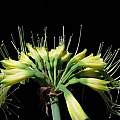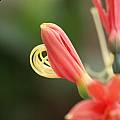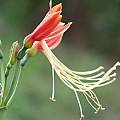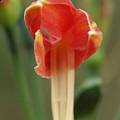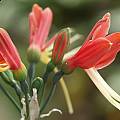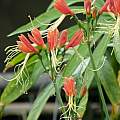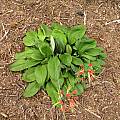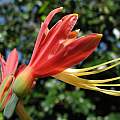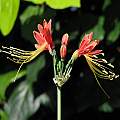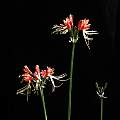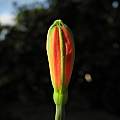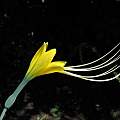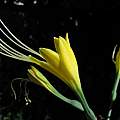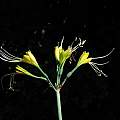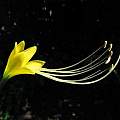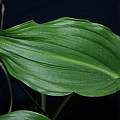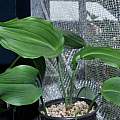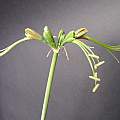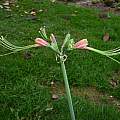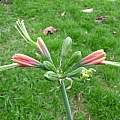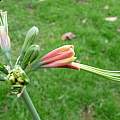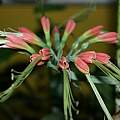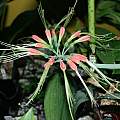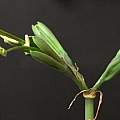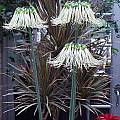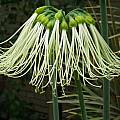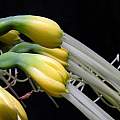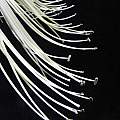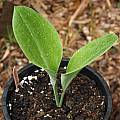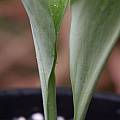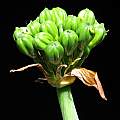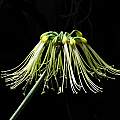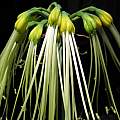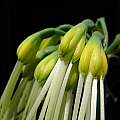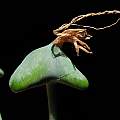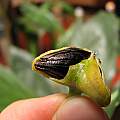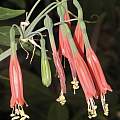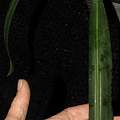Eucrosia is a genus in the Amaryllidaceae family from the western slopes of South American, namely Ecuador and Peru. Most of the species are lowland species where they inhabit seasonally dry vegetation areas. The plants flower late spring or early summer, before the leaves appear. They require a well drained soil, bright light and a temperature that remains above 50 °F. Flowers are in umbels on tall stems, and some species have extremely reduced tepals but very long stamens that give the umbel the appearance of an elegant mop! Numerous offsets are produced; plants can also be raised from seed.
Eucrosia aurantiaca is a species that is native to Ecuador with 6 to 14 gold yellow flowers in an umbel. Photos 1-2 by Mary Sue Ittner taken June 2007 in the greenhouse of Telos Rare Bulbs. Photos 3-6 were taken by Nhu Nguyen of a plant grown by Uluwehi Knecht.
Eucrosia bicolor is native to Ecuador and Peru. This species grows very well in tropical climates. It produces plenty of leaves (as seen in photo #6) and multiplies quickly. There seems to be only one clone in cultivation because attempts to pollinate plants from multiple accessions did not result in seed production. Grow the bulbs in good sunlight (partial/filtered sun) and give the plant plenty of water during the summer growing season. Once the leaves start to die down in response to winter, stop watering and allow the bulbs to have a dry winter dormancy which will trigger flower formation for the spring. Keep the bulbs pot-bound (1 gallon) to induce mass blooming. Photos #1-4 by Uluwehi Knecht, #5 by Colin Davis.
The photos below were taken by Nhu Nguyen showing various aspects of the species. Photo 1 was taken at the Koko Crater Botanical Garden, Hawai'i.
Eucrosia dodsonii is native to the understory of primary forests in Ecuador, around 1400 m. One of the distinguishing characteristics of this species to others in the genus are the deeply plicate leaves. Photos were taken by Nhu Nguyen of a plant grown by Uluwehi Knecht.
Eucrosia eucrosioides is native to southwestern Ecuador and northern Peru. Flowers start out as a greenish shade, fading to a glaucous red. The green stamens are long (9 cm) and strongly curved with matching equally long style (10 cm). Photos 1-4 by Alessandro Marinello. Photos 5-6 by Nhu Nguyen of a plant grown by Uluwehi Knecht.
Photo from Rimmer deVries of a plant originally from Catacochia, Ecuador which came from Dylan Hannon 6 years ago (written in 2020). Bulb is about the size of a walnut planted in non washed horticultural pumice (only). Scape is about 14" tall. Flowers open green.
Eucrosia mirabilis is native to Ecuador. Photos 1-2 were taken by Dave Brastow who wrote: "I encountered it for the first time at the National Arboretum in Washington, D.C. The flowers are on a stalk about 80 cm tall. Each umbel is 20 cm across. There were numerous spherical bulbs, many about 10 cm in diameter, sitting at the soil surface. The leaves, which appear after the flowers, are about 15 cm wide by 30 cm long on a mature plant." This species should be grown in very good to almost full sun. Water well during the summer growing season. Once the large spatulate leaves (either 1 or 2) start turning yellow, stop watering and allow the plant to go dormant for the winter. Photos 3-6 by Uluwehi Knecht show floral details and the foliage of a plant grown in Honolulu, Hawai`i.
The photos below were taken by Nhu Nguyen showing various aspects of the flowers from bud to seeds.
Eucrosia stricklandii Photos by Dylan Hannon who comments "collected by William Baker (no. 6885) in Ecuador, locality unknown. Easily recognized by its tubular Stenomesson like flowers and narrow leaf blades. A slow-growing species, culture as for Eucrosia eucrosioides, with a cool dry winter rest."
